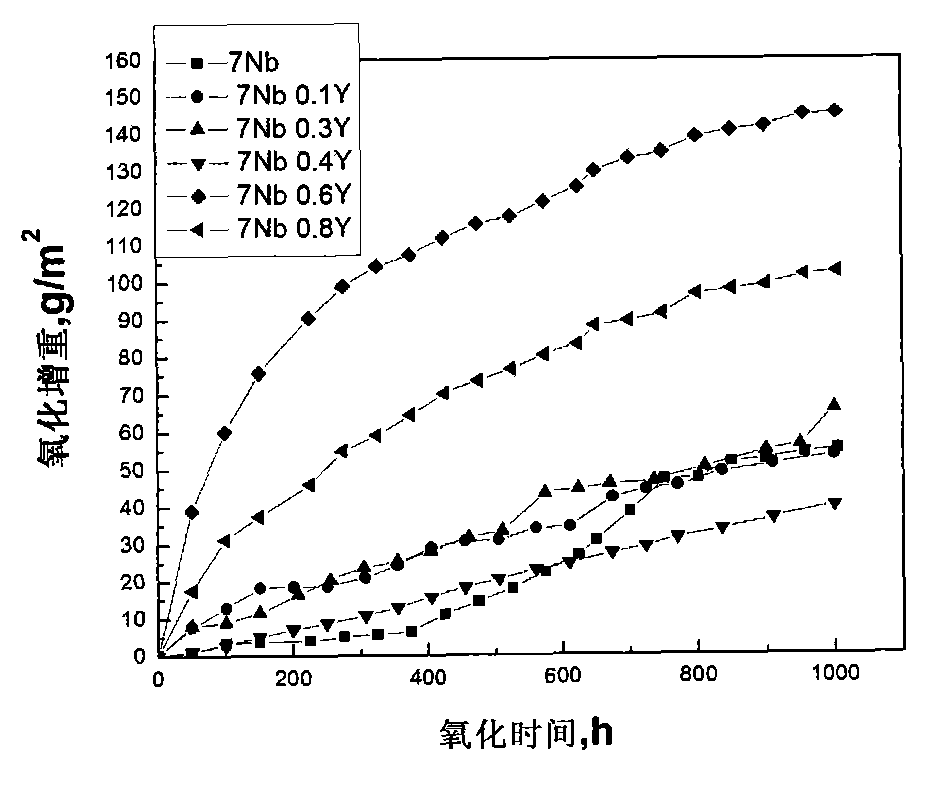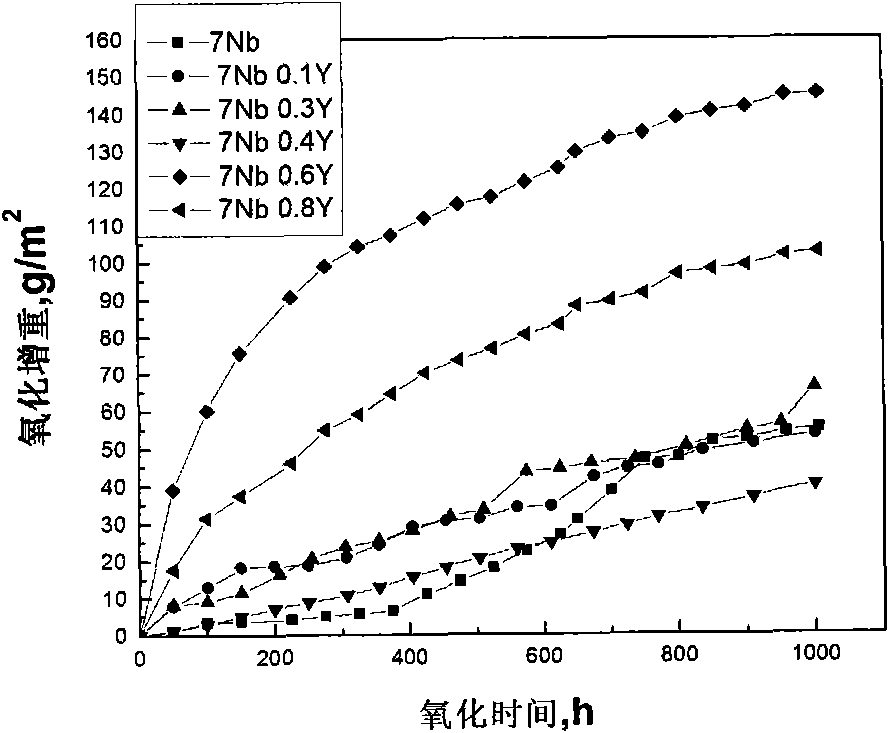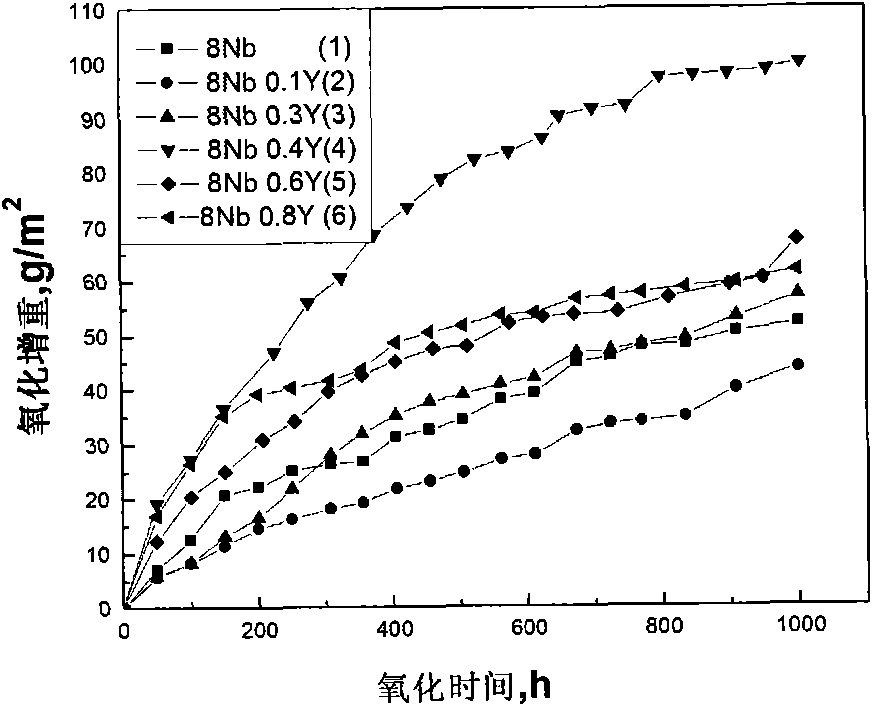Method for improving long-term oxidation resistance of high-niobium titanium-aluminum alloy through adding yttrium at high temperature
A technology of titanium aluminum alloy and oxidation resistance, which is applied in the field of long-term oxidation resistance at high temperature, can solve the problems of long-term oxidation resistance and oxide film adhesion that have not been reported, and achieve high-temperature long-term oxidation resistance and anti-stripping ability , the effect of reducing the oxidation rate
- Summary
- Abstract
- Description
- Claims
- Application Information
AI Technical Summary
Problems solved by technology
Method used
Image
Examples
Embodiment 1
[0031] The alloy whose nominal composition is Ti-45Al-7Nb-(0, 0.1, 0.3, 0.4, 0.6, 0.8) Y is smelted in vacuum. After homogenization, the wire is cut into a size of 10×10×1mm. 3 For thin slices, the six surfaces of the sample were ground to 1200 grit with SiC sandpaper from coarse to fine, and then ultrasonically cleaned in acetone for 15 min. The isothermal oxidation experiment was carried out in a box-type resistance furnace, the experimental medium was still air, and the experimental temperature was 900 °C. In order to ensure that the six surfaces of the sample are in contact with the air, the measured sample is placed obliquely in the corundum crucible, and the crucible is taken out after being oxidized for a certain period of time. After the sample is cooled, it is weighed. Put it into the furnace for oxidation, and the sample is oxidized for 1000h cumulatively. Figure 1 shows the oxidation weight gain curve. The Ti-45Al-7Nb-0.4Y alloy shows the best oxidation resistance,...
Embodiment 2
[0033] The alloy whose nominal composition is Ti-45Al-8Nb-(0, 0.1, 0.3, 0.4, 0.6, 0.8) Y is smelted in vacuum. After homogenization, the wire is cut into a size of 10×10×1mm. 3For thin slices, the six surfaces of the sample were ground to 1200 grit with SiC sandpaper from coarse to fine, and then ultrasonically cleaned in acetone for 15 min. The isothermal oxidation experiment was carried out in a box-type resistance furnace, the experimental medium was still air, and the experimental temperature was 900 °C. In order to ensure that the six surfaces of the sample are in contact with the air, the measured sample is placed obliquely in the corundum crucible, and the crucible is taken out after oxidizing for a certain period of time, and the sample is weighed after cooling. Put it into the furnace for oxidation, and the sample is oxidized for 1000h cumulatively. Figure 2 is the oxidation weight gain curve, the Ti-45Al-8Nb-0.1Y alloy shows the best oxidation resistance, and its ox...
Embodiment 3
[0035] The alloy with the nominal composition of Ti-45Al-8Nb-(0, 0.3, 0.4, 0.6, 0.8) Y is smelted in vacuum. After homogenization, the wire is cut into a size of 10×10×1mm. 3 Thin slices were drilled with electric sparks on one side of the sample, and the six surfaces of the sample were ground from coarse to fine to 1200 grit with SiC sandpaper, and then ultrasonically cleaned in acetone for 15 min. The sample was hung in the circulating oxidation furnace for the cyclic oxidation experiment. The experimental medium was still air, the experimental temperature was 900 °C, the high temperature oxidation in the furnace was 1 hour, and the room temperature outside the furnace was cooled for 12 minutes. After 300 cycles, the oxide film did not fall off obviously, but the oxide film fell off due to thermal stress in the cooling process after 300 cycles. Figure 3 shows the cyclic oxidation weight gain curve, and the oxidation rate increases with the increase of Y content.
PUM
 Login to View More
Login to View More Abstract
Description
Claims
Application Information
 Login to View More
Login to View More - R&D
- Intellectual Property
- Life Sciences
- Materials
- Tech Scout
- Unparalleled Data Quality
- Higher Quality Content
- 60% Fewer Hallucinations
Browse by: Latest US Patents, China's latest patents, Technical Efficacy Thesaurus, Application Domain, Technology Topic, Popular Technical Reports.
© 2025 PatSnap. All rights reserved.Legal|Privacy policy|Modern Slavery Act Transparency Statement|Sitemap|About US| Contact US: help@patsnap.com



